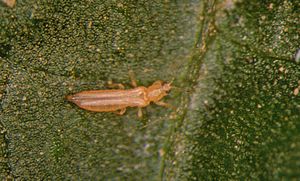Western flower thrips facts for kids
The western flower thrips is a tiny insect. It is a common pest in farming. This thrips comes from the Southwestern United States. But it has spread to many other places. These include Europe, Australia, and South America. It travels on plants.
Quick facts for kids Western flower thrips |
|
|---|---|
 |
|
| Scientific classification | |
| Genus: |
Frankliniella
|
| Species: |
occidentalis
|
Contents
About the Western Flower Thrips
The western flower thrips eats over 500 types of plants. This includes many fruits, vegetables, and garden flowers.
What They Look Like
Adult male thrips are about 1 mm long. Females are a bit bigger, about 1.4 mm long. Most western flower thrips are female. Males are rare and always pale yellow. Females can be different colors. They might be red, yellow, or dark brown. Their color often changes with the season.
Each adult thrips is long and thin. It has two pairs of long wings. The eggs are oval or kidney-shaped. They are white and about 0.2 mm long. Young thrips, called nymphs, are yellowish. They have red eyes.
Their Life Cycle
The life cycle of the western flower thrips changes with the temperature. An adult thrips lives for two to five weeks or more. The nymph stage lasts from five to 20 days.
Each female can lay 40 to over 100 eggs. She lays them inside the plant's tissues. This is often in the flower. But eggs can also be in the fruit or leaves.
When a nymph hatches, it feeds on the plant. It does this for two stages of its growth. Then, it falls off the plant. It finishes its last two growth stages there.
How They Affect Plants
These insects harm plants in several ways. The main damage happens when the adult lays eggs in the plant. The plant also gets hurt when the thrips feed. This leaves small holes. It also causes silvery spots. These spots appear when the plant reacts to the insect's spit.
Young nymphs eat a lot of new fruit. This happens when the fruit is just starting to grow from the flower. The western flower thrips also spreads a serious plant disease. It is called tomato spotted wilt virus (TSWV). If a thrips gets TSWV when it is young, it eats more. This can make it live longer.
How to Control Them
Western flower thrips are a problem all year. But they cause less damage when the weather is wet. You can reduce damage by planting barriers. These are plants that thrips do not like. You can also remove "reservoir plants." These are plants that thrips really love, like jimson weed.
Natural enemies of the thrips include pirate bugs. These bugs belong to the group Orius. Other things can also help control them. These include a fungus called Metarhizium anisopliae. Another helpful insect is the mirid bug Dicyphus hesperus.
Thrips and Humans
Thrips that feed on flowers are drawn to bright colors. They especially like white, blue, and yellow. They will land on these colors and try to feed. Some flower thrips might "bite" humans wearing bright clothes. But they do not feed on blood. These bites do not spread diseases. However, they can cause skin irritation.
See also
 In Spanish: Frankliniella occidentalis para niños
In Spanish: Frankliniella occidentalis para niños

